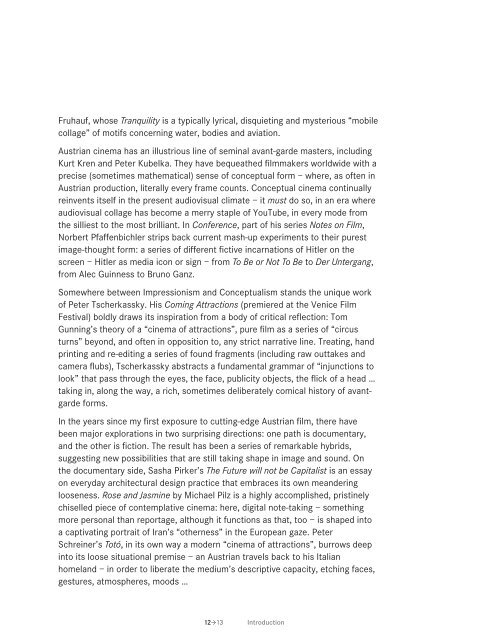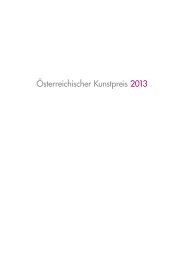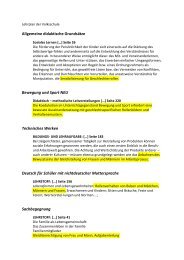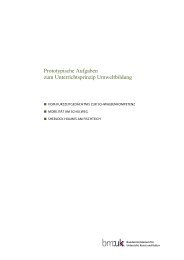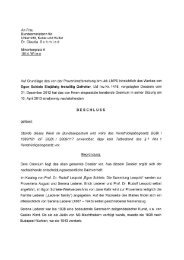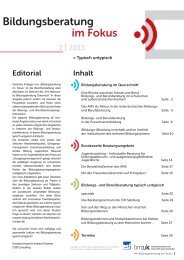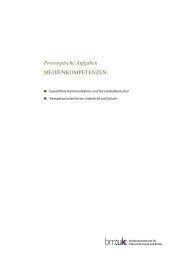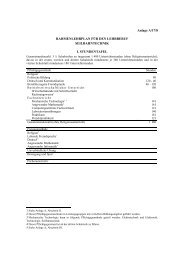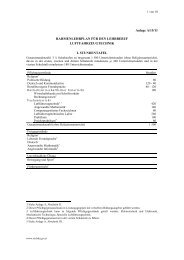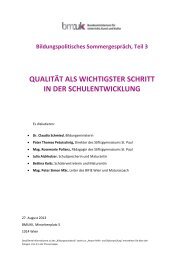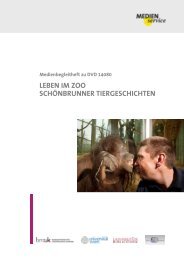Innovative Film Austria 10/11
Innovative Film Austria 10/11
Innovative Film Austria 10/11
Create successful ePaper yourself
Turn your PDF publications into a flip-book with our unique Google optimized e-Paper software.
Fruhauf, whose Tranquility is a typically lyrical, disquieting and mysterious “mobile<br />
collage” of motifs concerning water, bodies and aviation.<br />
<strong>Austria</strong>n cinema has an illustrious line of seminal avant-garde masters, including<br />
Kurt Kren and Peter Kubelka. They have bequeathed filmmakers worldwide with a<br />
precise (sometimes mathematical) sense of conceptual form – where, as often in<br />
<strong>Austria</strong>n production, literally every frame counts. Conceptual cinema continually<br />
reinvents itself in the present audiovisual climate – it must do so, in an era where<br />
audiovisual collage has become a merry staple of YouTube, in every mode from<br />
the silliest to the most brilliant. In Conference, part of his series Notes on <strong>Film</strong>,<br />
Norbert Pfaffenbichler strips back current mash-up experiments to their purest<br />
image-thought form: a series of different fictive incarnations of Hitler on the<br />
screen – Hitler as media icon or sign – from To Be or Not To Be to Der Untergang,<br />
from Alec Guinness to Bruno Ganz.<br />
Somewhere between Impressionism and Conceptualism stands the unique work<br />
of Peter Tscherkassky. His Coming Attractions (premiered at the Venice <strong>Film</strong><br />
Festival) boldly draws its inspiration from a body of critical reflection: Tom<br />
Gunning’s theory of a “cinema of attractions”, pure film as a series of “circus<br />
turns” beyond, and often in opposition to, any strict narrative line. Treating, hand<br />
printing and re-editing a series of found fragments (including raw outtakes and<br />
camera flubs), Tscherkassky abstracts a fundamental grammar of “injunctions to<br />
look” that pass through the eyes, the face, publicity objects, the flick of a head …<br />
taking in, along the way, a rich, sometimes deliberately comical history of avantgarde<br />
forms.<br />
In the years since my first exposure to cutting-edge <strong>Austria</strong>n film, there have<br />
been major explorations in two surprising directions: one path is documentary,<br />
and the other is fiction. The result has been a series of remarkable hybrids,<br />
suggesting new possibilities that are still taking shape in image and sound. On<br />
the documentary side, Sasha Pirker’s The Future will not be Capitalist is an essay<br />
on everyday architectural design practice that embraces its own meandering<br />
looseness. Rose and Jasmine by Michael Pilz is a highly accomplished, pristinely<br />
chiselled piece of contemplative cinema: here, digital note-taking – something<br />
more personal than reportage, although it functions as that, too – is shaped into<br />
a captivating portrait of Iran’s “otherness” in the European gaze. Peter<br />
Schreiner’s Totó, in its own way a modern “cinema of attractions”, burrows deep<br />
into its loose situational premise – an <strong>Austria</strong>n travels back to his Italian<br />
homeland – in order to liberate the medium’s descriptive capacity, etching faces,<br />
gestures, atmospheres, moods …<br />
12>13 Introduction


